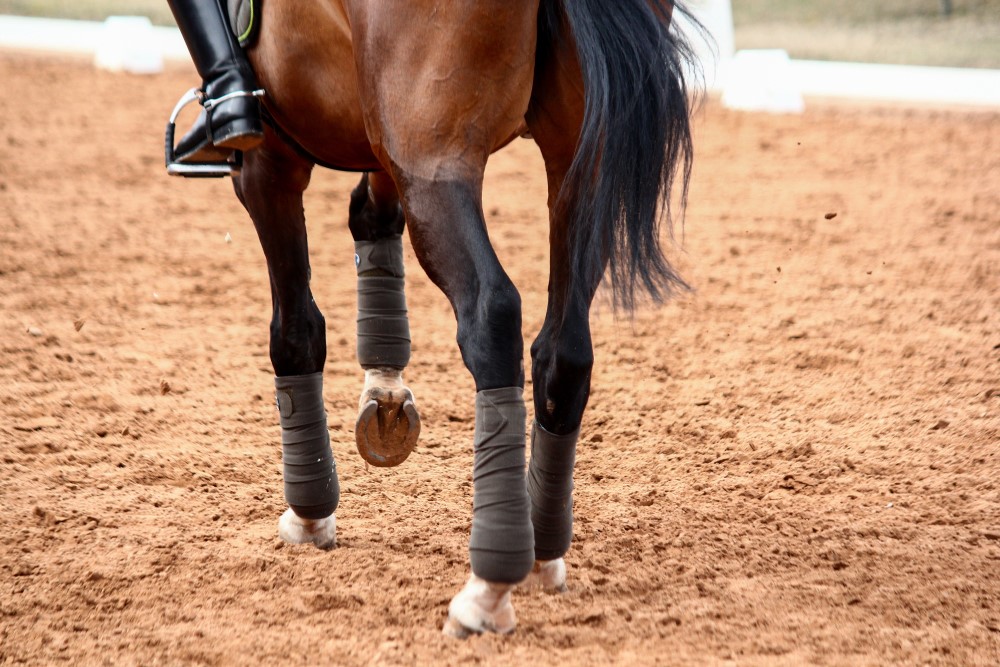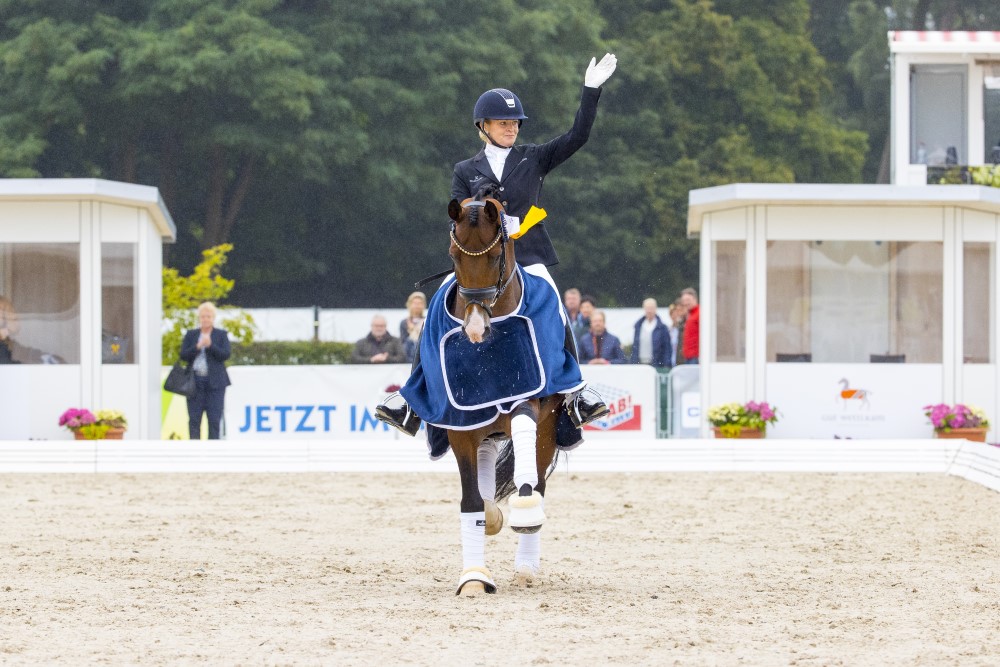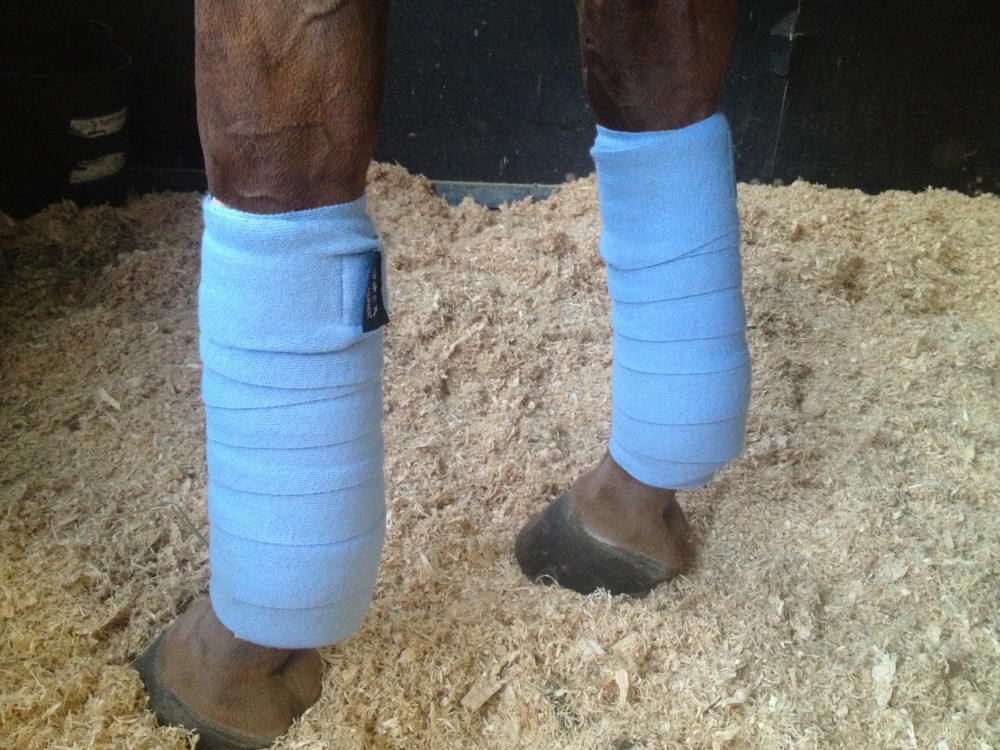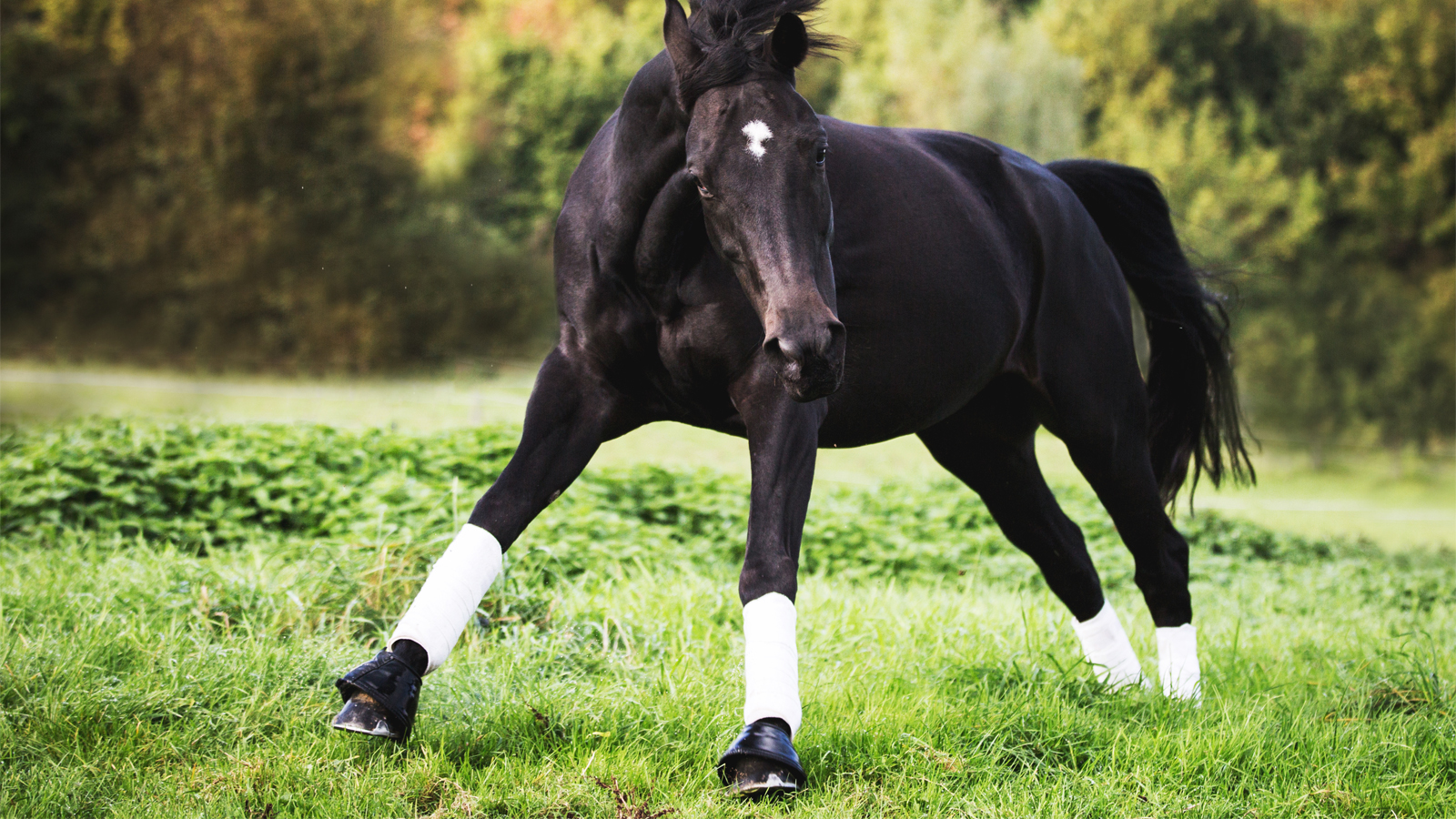The recent banning of bandages by the Royal Dutch Equestrian Federation (KNHS) is reported to have been implemented due to animal welfare concerns. The rationale behind the ban was that bandages offer no protection to the equine tendon and are in fact detrimental as they cause overheating of the tendons. Not all bandaging is bad; it is the indiscriminate use of bandaging tendons for work-related purposes that is being deterred.
Tendons are dense connective tissues that are designed to store energy and then use this energy to help propel the limbs in an efficient, effective way. However, as with any body function, this transfer of energy from the tendons into movement is not 100% efficient and energy is lost in the form of heat as the horse exercises. Tendons have a low blood supply and therefore cannot dissipate this generated heat via the bloodstream to the skin as happens with other tissues, allowing this heat to build up. When the lower limbs are bandaged, the heat in the tissues is amplified as it cannot be lost directly to the environment.

The recent banning of bandages by the Royal Dutch Equestrian Federation (KNHS) is reported to have been implemented due to animal welfare concerns.
Although it has been known for several decades that bandaging legs can be detrimental during exercise due to the heat that is generated within the limbs, it is only recently that more attention has been paid to the studies relating to this. The propulsion of equine welfare to the forefront of many equine regulatory bodies has meant that many of these types of scientific studies are being evaluated and acted upon to ensure the horse’s welfare is paramount. Instead of observations and recommendations, rules are being made and implemented to ensure participants act to prevent injuries occurring, as is the intention of the rule barring the wearing of bandages during KNHS events.
By placing thermistor probes into tendons and the surrounding tissues, researchers were able to track the temperatures reached in the tendon during exercise and demonstrate how different types of bandages can influence the degree of warming that occurs. Polo fleece boots were implicated as causing the highest temperature increases, whereas Stomatex and neoprene boots yielded the smallest of the increases seen in the tendons when boots/bandages were worn.
‘COOKING LIKE AN EGG’
Temperatures in the tendon where core lesions occur were detected as high as 45 degrees during exercise in these studies, which is where the analogy of “cooking the horse’s tendon like an egg” has originated. However, it has also been shown scientifically that the tendon fibroblasts are also more resistant to hyperthermia than other types of fibroblasts and can withstand this temperature without “cooking”. Therefore, if bandages need to be applied for a specific reason (for instance, a wound), they can be applied for a limited time without the fear of permanently damaging the tendon.
If used, however, any bandages should be removed as soon as the exercise is finished, and the legs be iced or hosed if practical to do so. The danger arises when bandages are worn daily during exercise for no specific medical reason as there is likely to be a cumulative effect of heat generated within the tendon that eventually leads to injury.

In some instances a horse may need bandages to protect the legs for a short period, such as a young horse during a prizegiving presentation. Image by FEI – Leanjo de Koster.
We also need to put these studies into context, as tendon lesions are not simply a result of hyperthermia that is multiplied by the application of bandages when exercising. If this were the case, we would see similar numbers of core lesions in the front and hind limbs, which we do not. Forelimb tendon lesions are far more common because of the increased workload on the forelimbs, as approximately 60% of the body weight of the horse is in the front. Tendon injuries generally occur due to an accumulation of microdamage and not necessarily the result of a single incident, and there are several factors that are involved, not only hyperthermia. Overstraining, hyperthermia, poor shoeing, and uneven or inconsistent footing can all cause microdamage and it is the build-up of all these small insults that culminate in a damaged tendon. Even age is a factor when it comes to tendon damage as mature tendon loses the ability to adapt to exercise, unlike other tissues such as muscle that can be built up with training.
DAMAGE ALREADY DONE
The lack of a good method of detecting microdamage – one that could alert us to the fact that the tendon is beginning to become compromised before we detect the full tendon lesion – is one of the key reasons we cannot significantly decrease the incidence of tendon injuries. For most veterinarians, the ultrasound machine is the most common investigative tool we use to examine tendons, but the ability to detect minute changes is not feasible on standard machines. Detecting damage in the tendon relies on the operator identifying an enlargement of the cross-sectional area of the tendon, visualising hyperechoic areas (darker areas or holes) and assessing fibre alignment. Unfortunately, once these changes have been detected, the damage has already been done.
The other negative outcome attributed to bandages during work is the risk that they will come undone or loosen up and cause an injury. Whilst this can and does occur, bandages that slip are due to human error and should not be blamed on the bandages themselves. Whilst the more recent study implied that bandages/boots offered no protection to the legs, I would not agree with this comment. Bandaging limbs to prevent the fetlock from dropping excessively and therefore putting extra strain on the tendon may not be effective, however, bandaging or booting a horse’s limbs to prevent a direct trauma to the leg is a worthwhile exercise. I have seen several horses slice straight through their superficial digital flexor tendon when spooked or misstepping during exercise, and this has been a disastrous result for the owners.

It is important to assess all the factors and the reasoning behind the use of bandages.
I have also seen instances where the horse has struck the forelimb whilst wearing a boot and the impact has torn right through the boot and only cut the outer layer of skin; had the horse been naked, the tendon would have been severed.
Therefore, it is important to assess all the factors and the reasoning behind the use of bandaging/booting before condemning their use during exercise entirely. Instead, the focus should be on the design of a boot that protects the tendon and allows heat to be disseminated to the environment, as this would provide a sensible solution to the current issue. EQ
YOU MIGHT ALSO LIKE TO READ BY DR MAXINE BRAIN:
Diagnosing Respiratory Issues – Equestrian Life, March 2024
Anhidrosis: What Is Is? – Equestrian Life, January/February 2024
Fractured Jaws – Equestrian Life, December 2023
Keeping Our Country Free of Disease – Equestrian Life, November 2023
Managing Endometritis – Equestrian Life, October 2023
Granulosa Cell Tumours – Equestrian Life, September 2023
Being a Horse in Africa – Equestrian Life, August 2023
Splint Bone Fractures – Equestrian Life, July 2023
When Horses Choke – Equestrian Life, June 2023
The Challenge of Treating HPSD – Equestrian Life, May 2023
From the Horse’s Mouth: Salivary Glands – Equestrian Life, February 2023
Cardiac Murmurs – Equestrian Life, February 2023
Matters of the Heart – Equestrian Life, January 2023
Umbilical Concerns in Foals – Equestrian Life, December 2022
Retained Foetal Membranes – Equestrian Life, October 2022
Preparing for Laminitis – Equestrian Life, September 2022
Working Together for Best Outcomes – Equestrian Life, August 2022
What Constitutes an Emergency – Equestrian Life, July 2022
Peri-Tarsal Cellulitis Calls for Quick Action – Equestrian Life, June 2022
Sinusitis: Not To Be Sneezed At – Equestrian Life, May 2022
Japanese Encephalitis: No Cause For Alarm – Equestrian Life, April 2022
Hernia Learning Curve – Equestrian Life, March 2022
Osteochondromas: Benign But Irritating – Equestrian Life, February 2022
Don’t Forget the Water – Equestrian Life, January 2022
Don’t Forget the Water – Equestrian Life, January 2022
Understanding Anaesthesia – Equestrian Life, December 2021
A Quick Guide to Castration – Equestrian Life, November 2021
Caring for Mammary Glands – Equestrian Life, October 2021
Sepsis In Foals – Equestrian Life, September 2021
Understanding Tendon Sheath Inflammation – Equestrian Life, August 2021
The Mystery of Equine Shivers – Equestrian Life, July 2021
Heads up for the Big Chill – Equestrian Life, June 2021
The Ridden Horse Pain Ethogram – Equestrian Life, May 2021
The Benefits of Genetic Testing – Equestrian Life, April 2021
Heavy Metal Toxicities – Equestrian Life, March 2021
Euthanasia, the Toughest Decision – Equestrian Life, February 2021
How to Beat Heat Stress – Equestrian Life, January 2021
Medicinal Cannabis for Horses – Equestrian Life, December 2020
Foal Diarrhoea Part 2: Infectious Diarrhoea – Equestrian Life, November 2020
Foal Diarrhoea (Don’t Panic!) – Equestrian Life, October 2020
Urticaria Calls For Detective Work – Equestrian Life, September 2020
Winter’s Scourge, The Foot Abscess – Equestrian Life, August 2020
Core Strengthening & Balance Exercises – Equestrian Life, July 2020
The Principles of Rehabilitation – Equestrian Life, June 2020
When is Old, Too Old? – Equestrian Life, May 2020




